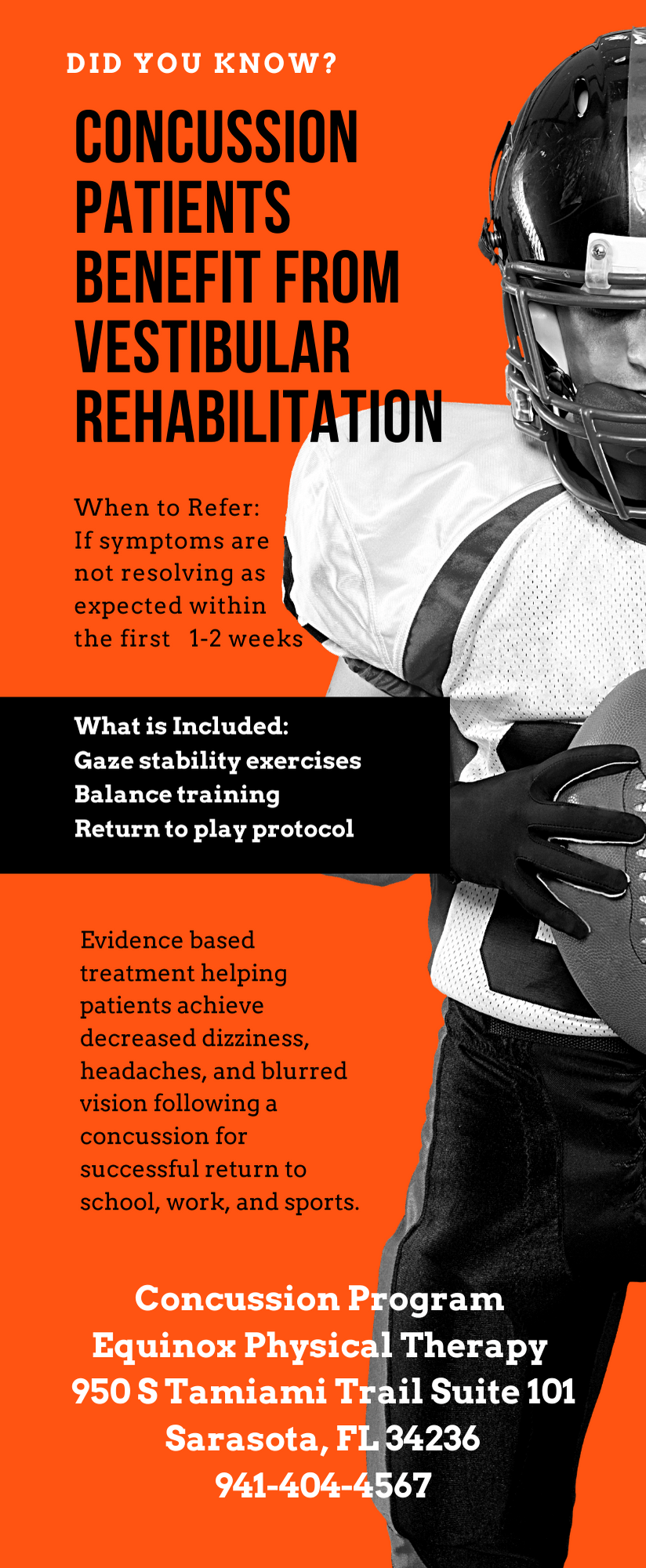Laura Wazen, DPT
Equinox Physical Therapy
Our expert physical therapists provide treatment and relief from these common issues:
Hannah Leatherman, DPT
Benign Paroxysmal Positional Vertigo (BPPV)
Facial Paralysis
Inner Ear Weakness
Meniere’s Disease
Balance Problems
Stroke
Concussion
Fall Prevention
Parkinson’s Disease
Balance Therapy and Physical Therapy Goals
Balance therapy is a generalized category of physical therapy exercises to help an individual improve their balance. The ultimate goals of balance therapy are to prevent falls and increase a person’s functional abilities and independence, both at home and in the...
Dizziness and the Visual System
One really cannot understand how much we use our vision to help us balance until it is taken away. That is why a standardized test for balance is to stand with feet together and eyes closed. The test is called the Romberg test, and the goal for most adults regardless...
VOR exercises for Dizziness and Balance Problems
The Vestibular Ocular Reflex (VOR) is the mechanism that allows a person to keep their eyes on a fixed target while their head is moving, for instance when you are looking at your friend and nodding your head “yes” or “no”. The reason we are able to do this is...
Top 5 Signs of Visual Problems in Children
My physical therapy practice in Sarasota, Florida, is devoted to helping people with balance and inner ear problems. So you may be wondering why I am writing about visual problems The reason is: vision is extremely important in maintaining good balance! We use our...
What are Acoustic Neuromas?
Acoustic Neuromas are nerve sheath tumors surrounding the vestibular or cochlear nerves. The vestibular nerve is the balance nerve that goes from the inner ear to the brain. The cochlear nerve is the hearing nerve that goes from the cochlea to the brain. When the...
Superior Semicircular Canal Dehiscence Research
Last year I wrote an article for my blog about anxiety and inner ear problems based on the research by Dr. P. Ashley Wackym. It turns out that it has been one of my most frequently visited blog posts! Last October 2015, I saw Dr. Wackym again when we were both...
BPPV and Christmas Trees- A Holiday Tip From Dr. Laura Wazen
It’s that time a year for the annual trip to the Christmas tree lot. When a person has Benign Paroxysmal Positional Vertigo (BPPV), bending the head down, or tipping the head back, can trigger a vertigo spell. It goes without saying, that if you are standing on a...
Top 4 Questions Regarding Out of Network Outpatient Physical Therapy Services & Insurance Coverage
Money Matters (Selected Part of Letters from Aunt Evelyn), conceptual art by Barton Lidice Benes, 1982. This is an article that I thought I would never write. When I first started working as a physical therapist, I worked for a big hospital in Manhattan. I never had...
Can People Have BPPV in Both Ears?
BPPV (Benign Paroxysmal Positional Vertigo) is the most common type of inner ear problem, comprising approximately 25% of all inner ear problems. It is caused when crystals in the ear that are supposed to sit on top of the nerve fibers in a jelly like matrix,...
Balance Problems and Shoes- 7 Tips on Finding the Proper Shoe
Do the shoes you are wearing matter when you have a balance problem or a history of falling? The answer to this question is ABSOLUTELY! I still remember the lady who came to see me for balance therapy in Sarasota, Florida with complaints of falling. She was wearing...

Our Approach
Listen. Listening is the most important step in understanding a patient’s concern. It is the most basic beginning, and in health care today, so often undervalued. It directs understanding, the direction of testing, and the formulation of a plan. It is the most important step in paving the road to treatment and recovery.
Learn. Our role is not only to learn from our patients but to guide them in how to learn from us, and what they should do to take back their lives and create positive change.
Live. Life is a gift. The purpose of all treatment at Equinox Physical Therapy is to restore function, independence, and freedom to clients recovering from or living with an illness.














